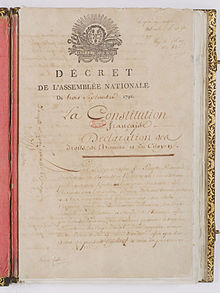French Constitution (1791)
The French constitution of 1791 , passed by the constituent national assembly exactly four months after the constitution of Poland - on September 3, 1791 - came into being in the course of the French Revolution . With it, revolutionary France was transformed from an absolute to a constitutional monarchy , which, however, only lasted for around a year (see the timetable for the French Revolution ).
executive
At the head of the executive was the king , who was allowed to appoint and dismiss his ministers who supervised the officials in the 83 departments and municipalities . The civil servants were introduced to their offices through the election of active citizens . The King, together with the Legislative National Assembly, had control of the armed forces , with sole supreme command in the event of war . In addition, the king had a suspensive veto on the legislative proposals of the National Assembly, ie he could postpone a bill for two legislative terms (four years).
legislative branch
For the legislature is Legislative Assembly responsible that every two years by electors was chosen. The electors (approx. 45,000) in turn were elected every two years by the active citizens (approx. 4.3 million) (one voter for 100 voters). The National Assembly, together with the King, had supreme command of the armed forces (see above for exception) and controlled the ministers and the courts of law. The assembly consisted of 745 members. Of these, 247 were selected according to the area, 249 according to the population and another 249 according to the tax revenue. Constitutional changes could only be tackled if the parliament expressed the corresponding wish in two legislative periods. In the third legislative period, a revision assembly was then formed, which consisted of the National Assembly and a further 249 members elected for this purpose only.
Judiciary
The judiciary was divided into three different judicial institutions: First, the High Court, which could be convened by the National Assembly and ruled on the offenses of statesmen. In second place the appellate court and in third place the courts of justice, whose judges and jury were elected every two years by the active citizens.
Eligible voters
In France, the so-called census suffrage was applied , which means that every man over 25 years of age who had a certain tax revenue had the right to vote. These men were called active citizens.
Passive citizens were considered to be the dispossessed men who had either no or very little tax revenue (various sources speak of 1.5 or 3 livres tax revenue) and therefore did not have the right to vote. An indirect electoral system ensured that only a limited group of active citizens chose the members of the National Assembly: the active citizens who paid direct taxes worth at least three working days first elected electors who paid direct taxes worth at least 10 working days. And these only 50,000 electors finally elected the MPs, who either paid direct taxes worth around 100 working days or were landowners. But they could get the right to vote once they had paid enough taxes. Non-taxpayers, men under the age of 25 and women were without any political say.
swell
- Constitution de 1791. Conseil constitutionnel , accessed December 14, 2014 (French).
- French Constitution of September 3, 1791. In: Constitutions of the World. Andreas Clement, accessed December 14, 2014 .

